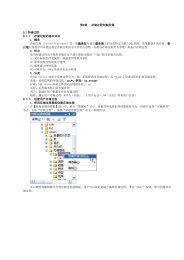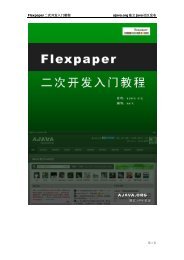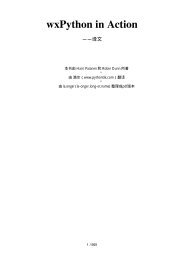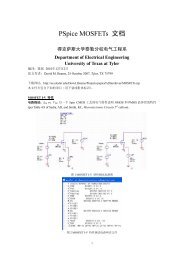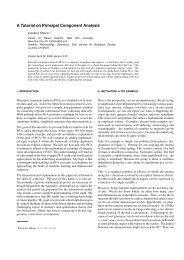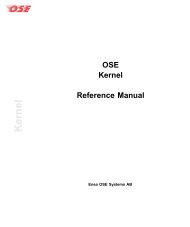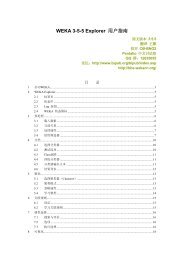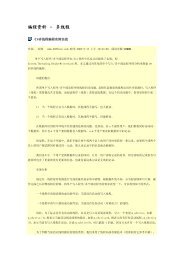Exception Handling ABI for the ARM Architecture
Exception Handling ABI for the ARM Architecture
Exception Handling ABI for the ARM Architecture
Create successful ePaper yourself
Turn your PDF publications into a flip-book with our unique Google optimized e-Paper software.
<strong>Exception</strong> handling <strong>ABI</strong> <strong>for</strong> <strong>the</strong> <strong>ARM</strong> architecture<br />
- The PR has just been entered <strong>for</strong> <strong>the</strong> first time <strong>for</strong> this frame.<br />
- The UCB pr_cache and barrier_cache substructures are valid.<br />
2. The PR should now examine <strong>the</strong> EHT entry and <strong>the</strong> barrier_cache to decide what to do. It should return one<br />
of:<br />
- _URC_FAILURE<br />
- _URC_CONTINUE_UNWIND<br />
- _URC_INSTALL_CONTEXT<br />
3. _URC_FAILURE indicates that some error occurred that prevented fur<strong>the</strong>r processing. The unwinder will call<br />
abort().<br />
4. _URC_CONTINUE_UNWIND indicates that <strong>the</strong> current frame has been fully dealt with, and that <strong>the</strong> PR has<br />
virtually unwound <strong>the</strong> frame. The PR does this by updating <strong>the</strong> VRS to reflect <strong>the</strong> machine state at <strong>the</strong> call to<br />
<strong>the</strong> current function, using <strong>the</strong> frame-specific unwind description. In particular <strong>the</strong> virtual unwind should set<br />
VRS[r15] to <strong>the</strong> return address into that previous function. The unwinder will (re)enter _Unwind_Next_Frame<br />
to initiate unwinding of <strong>the</strong> parent frame. Go to step 1.<br />
5. _URC_INSTALL_CONTEXT instructs <strong>the</strong> unwinder to save any state it needs and <strong>the</strong>n to upload <strong>the</strong> virtual<br />
register set to <strong>the</strong> real machine registers. This causes <strong>the</strong> unwinder frames to vanish and whatever routine <strong>the</strong><br />
PR installed in VRS[r15] to be entered. The PR will make this return when it wants to run a cleanup or when it<br />
wants to enter <strong>the</strong> handler that was located during phase 1. The PR must have set up <strong>the</strong> VRS with <strong>the</strong><br />
required register-state to enter <strong>the</strong> designated code, including any arguments it knows it must pass. If <strong>the</strong> PR<br />
expects to eventually get control back (after running a cleanup) it must also save in <strong>the</strong> UCB cleanup_cache<br />
substructure whatever state-tracking in<strong>for</strong>mation it requires so it can resume scanning <strong>the</strong> EHT entry at <strong>the</strong><br />
correct place on re-entry. Note: In general an unwinder must load all <strong>the</strong> machine registers listed in <strong>the</strong> VRS.<br />
6. After a cleanup has finished, <strong>the</strong> unwind must be continued by passing <strong>the</strong> UCB pointer to _Unwind_Resume.<br />
A cleanup may exit via some language-specific <strong>ABI</strong>-defined routine (in C++, __cxa_end_cleanup) to do this.<br />
The cleanup may have made changes to <strong>the</strong> machine register state which must not be lost, <strong>for</strong> example<br />
updating <strong>the</strong> value of a variable held in a register. Thus _Unwind_Resume must copy <strong>the</strong> registers to <strong>the</strong><br />
VRS. It must set VRS[r15] to <strong>the</strong> value saved in step (1) as this may be required <strong>for</strong> fur<strong>the</strong>r scanning of <strong>the</strong><br />
EHT entry (and it must again preserve that value across <strong>the</strong> next PR call). _Unwind_Resume <strong>the</strong>n calls <strong>the</strong><br />
PR with state _US_UNWIND_FRAME_RESUME, <strong>the</strong> UCB pointer and an _Unwind_Context pointer. The PR<br />
should recover data that it saved in <strong>the</strong> UCB cleanup_cache, so that it can continue scanning <strong>the</strong> EHT entry<br />
from where it left off. Go to step 2.<br />
Note The language-specific cleanup exit routine must not corrupt any significant registers be<strong>for</strong>e calling<br />
_Unwind_Resume, and may <strong>the</strong>re<strong>for</strong>e require a small assembly wrapper if it additionally per<strong>for</strong>ms<br />
language-specific housekeeping. The intent of <strong>the</strong>se register rules is that <strong>the</strong> compiler should not be<br />
unduly constrained when code-generating a cleanup fragment, and that <strong>the</strong> fragment’s register saving<br />
can be minimised.<br />
Note<br />
It is expected that <strong>the</strong> unwinder will use <strong>the</strong> UCB unwinder_cache to preserve <strong>the</strong> VRS[r15] value over a<br />
PR call and cleanup.<br />
7.5 Virtual register set manipulation<br />
The <strong>ARM</strong> architecture defines a number of optional extensions such as VFP. The registers associated with such<br />
extensions are not present on all plat<strong>for</strong>ms; only <strong>the</strong> core (integer) registers are guaranteed present.<br />
(Aside: In this context a register is 'present' if instructions using it appear to work - <strong>the</strong> register (and instruction)<br />
could be physically present on <strong>the</strong> system or transparently emulated. End aside).<br />
The in-memory representation of saved registers is not necessarily identical to <strong>the</strong> bitpatterns notionally in <strong>the</strong><br />
registers, and very specific instruction sequences may be required to undo a register save. For example, restoring<br />
VFP registers saved by an FSTMX instruction, without using knowledge of <strong>the</strong> particular implementation, requires<br />
execution of <strong>the</strong> precisely matching FLDMX instruction. In <strong>the</strong> general case, <strong>the</strong> representation and target register<br />
<strong>ARM</strong> IHI 0038A Copyright © 2002-2005, 2007 <strong>ARM</strong> Limited. All rights reserved. Page 24 of 50



